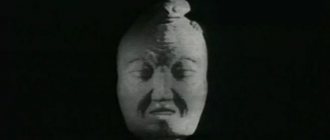Micropsia is one of the forms of distortion of visual perception of objects in the external environment and one’s own body, in which everything around seems smaller than it really is. Sometimes this disorder is called “Alice through the Looking Glass syndrome.” This disorder is not often encountered in neurological and psychiatric practice, but it can significantly limit a person’s daily activity. Moreover, he is worried not only about the micropsia itself, which can appear suddenly and disappear just as abruptly, but he is afraid of a second attack. Medical doctors will conduct a thorough examination of the patient, find out the cause of the disorder, prescribe appropriate treatment or refer you to a specialized specialist.
Micropsia: general description
The visual organ system is one of the most complex structures of our body. Although its anatomical structure has been studied in sufficient detail, the neurological and physiological mechanisms of processing information perceived by the eye are still completely unknown.
Everything we see around us is projected in the form of light rays onto the retina, the back wall of the eye. The rods and cones located in it transform them into electrical impulses, which are transmitted to the fibers of the optic nerve.
Interesting fact! The optic nerve contains about 1 million fibers, each connecting to approximately 140–150 rods and cones.
From the retina, the impulse enters the brain, or more precisely, to the visual cortex, which in humans (as, by the way, in other mammals) is located in the occipital region. Brain neurons “process” the received signals, and as a result, we perceive the surrounding reality as a holistic picture, and act in accordance with what we see.
With micropsia, a person does not perceive the real size of the objects around him. Unlike other vision pathologies (farsightedness, myopia, etc.), illusions and hallucinations are not distorted in their outlines, shape, and the general characteristics of the perceived information do not change (for example, with hallucinosis, it seems to the patient that things are coming to life, someone is in a closet, under the table, etc.).
Alice in Wonderland Syndrome
To read you need: 5 minutes.
Lewis Carroll, having written the fairy tale “Alice in Wonderland,” could not even imagine that one of the manifestations of such a migraine symptom as aura would be named after her.
Aura occurs in approximately 30% of people who suffer from migraines. With a migraine with an aura, a person can expect sparkling zigzags, dots, balls, distorted objects, fiery figures, flashes, and all this “laser show” flows into an attack of headache.2
Those who read or watched this fairy tale may have dreamed of getting into such a “wonderland”, where everything is different, everything is changing, everything is so interesting and exciting. However, in the case of a migraine attack, such miracles will not be to your taste.
Many famous artists suffered from migraines with aura. What do their paintings look like, the motives of which are inspired by the sensations during an attack?
Edvard Munch is one of the first expressionists; his most recognizable work is The Scream.1
The author suffered from migraines with aura, and this is how he saw everything around him. Everything floats, everything is distorted, even your own body. Edvard Munch reproduced this painting several times, as if trying to put all the pain into it and get rid of it.
Visual disturbances can manifest themselves not only as bright flashes before the eyes, but in the form of distorted objects, figures and one’s own body. Against the background of such manifestations of the aura, people around may seem like monsters.
Pablo Picasso, who according to the Dutch neurologist Michel Ferrari also suffered from migraines,1 perfectly depicted this in his works: facial features are blurred, the face itself is asymmetrical and seems monstrous.
Arms and legs seem not to be their own, parts of the body appear incorrect to a person during the aura that precedes an attack of migraine headache.
Lewis Carroll himself suffered from migraines, his fairy tale is created from his many visual illusions - people and objects seem unreal, distorted, and everything is constantly changing, just like at the moment of the aura itself.1
“Okay,” said the Cat and disappeared – very slowly this time. The tip of his tail disappeared first, and his smile last. She hovered in the air for a long time, when everything else had already disappeared.”
And the famous “pie”, which could be eaten and shrink, or, conversely, grow to unpredictable sizes, could be exactly the very food trigger of migraine that caused these visual paradoxes.
Important
In real life, it is important to know that an aura does not always happen, even quite rarely, and lasts no more than an hour, usually 15-20 minutes.2
So let's put it all together
An aura is a precursor to a headache. It does not occur to everyone, but it gives such a lot of sensations that many people suffering from this type of migraine consider the aura to be even more severe than the headache attack itself. The aura can manifest itself as:
- "floaters", flying balls or zigzag flashes before the eyes
- loss of areas of the visual field
- distorted perception of surrounding objects or one’s own body
- speech disorders
- numbness of half the face, tongue, body, or a “crawling” sensation2
Not the most pleasant thing, right? The aura is a kind of sign that an attack of painful headache will soon begin. It is important to know that specific migraine medications are most effective if taken at the very beginning of a headache attack. Therefore, if a person suffers from migraine with aura, during this period he already tries to make sure that he has a suitable migraine medication at hand. And if the headache increases, he will be able to quickly stop it at a very early stage.
One telephone interview with 688 people found that despite existing medications, not all patients are satisfied with the results of drug treatment for migraine:5 Why?5
Today, there is a group of drugs that have revolutionized the relief of migraine attacks with and without aura - these are triptans. They are created specifically for effective relief of attacks.
Important
Triptans have a specific property - they act directly on the vessels of the brain: they narrow the vessels dilated during a migraine attack and have a calming effect on overexcited nerve cells with abnormal activity.3
Research shows that triptans are the most effective, and their use significantly increases the chance of avoiding recurrence of migraine headaches.4
THE INFORMATION PROVIDED IS NOT A SUBSTITUTE FOR CONSULTING A DOCTOR. THERE ARE CONTRAINDICATIONS, YOU MUST CONSULT A SPECIALIST.
PP-REP-RUS-0132 06/18/2020
- References 1. S.P.Markin. Migraine and art. Consilium Medicum. 2012; 2: 91-96 2. L.S. Manvelov, A.V. Kadykov. Migraine. Directory of a polyclinic doctor. 2014; 08: 37-41 3. Ya.I.Levin. Choice of drug in the treatment of migraine. Consilium Medicum. 2007; 2: 138-140 4. A.P.Rachin, V.V.Osipova, Ya.B.Yudelson. Migraine: from correct diagnosis to adequate therapy. Directory of a polyclinic doctor. 2007; 01: 51-55 5. Lipton RB, Stewart WF. Acute migraine therapy: do doctors understand what patients with migraine want from therapy? Headache, 1999, 39: 30-48.
Did you like the article?
Micropsia: possible causes
Some experts suggest that this disorder may be caused by diseases of the organ of vision (paralysis of accommodation, retinal lesions, etc.). However, most doctors agree that micropsia is closely related to pathological changes in the visual cortex and dysfunction of the so-called detector neurons, which are “responsible” for recognizing visual impulses received from the retina.
The most common causes of micropsia include:
- epilepsy, and in children such visual distortions may be the only symptom of the disease; in adults, impaired perception is usually one of the manifestations of the aura preceding an attack;
- organic brain damage due to congenital anomalies, complications during childbirth;
- malignant tumors, benign and vascular neoplasms;
- migraine;
- previous ischemic or hemorrhagic stroke;
- severe traumatic brain injuries;
- complicated neuroinfections;
- brain surgery.
But sometimes micropsia is a consequence of various mental disorders, and the patient may not realize that his vision is distorted, and, accordingly, does not tell either his relatives or the doctor about it. Another cause of the syndrome is the use of drugs that belong to the class of hallucinogens.
Signs
Micropsia is an amazing, strange and unusual disease in the world of medicine. Symptoms of micropsia can manifest in the following ways:
- objects seem smaller to the child than they actually are (for example, a table may seem larger than the spoon lying on it);
- vertical surfaces may appear horizontal and vice versa;
- stationary objects, such as furniture, may begin to move and circle around the room;
- as a result, there is a possibility of disorientation.
Clinical picture
In neurological pathologies, micropsia is unpredictable. Only with epilepsy in a child or adult or migraine can one predict an impending attack.
In mental disorders, a similar syndrome is accompanied by a number of other specific symptoms. This:
- episodes of depersonalization and derealization: the patient sees himself as if from the outside, an image of a giant appears surrounded by familiar but small objects;
- disturbances of consciousness, when the patient has difficulty perceiving, analyzing and reacting to what is happening;
- accompanying illusions: sometimes micropsia is accompanied by visual, auditory and tactile hallucinations;
- the formation of delusional ideas, and visual impairment clearly “fits” into the structure of the delusion;
- anxiety, restlessness, fixation on certain aspects of professional or everyday life, one’s own health, episodes of panic attacks are not excluded;
- depressive state.
If the pathology is associated with damage to the central nervous system, the following are typical:
- frequent severe headaches;
- memory impairment;
- decrease in cognitive abilities, intelligence;
- seizures;
- deterioration of acuity, “loss” of certain areas from the field of view (outside episodes of micropsia).
In rare cases, a combination of neurological and mental pathologies is possible.
Diagnosis and treatment
To make a diagnosis, it is enough to study the patient’s complaints. There are no neurological disorders with a similar clinical picture, and therefore the possibility of misdiagnosis is extremely low. Some types of examination of the patient are used to determine the causes of the pathology. These include tomography, encephalography, and laboratory analysis of cerebrospinal fluid.
The principles and methods by which micropsia is treated in a child and an adult are practically the same. It is necessary to reduce the stress load on the psyche and eliminate the maximum number of possible irritants. It is extremely important to maintain a sleep schedule, sleeping at least 8 hours every day.
Cost of services
| CONSULTATIONS OF SPECIALISTS | |
| Initial consultation with a psychiatrist (60 min.) | 6,000 rub. |
| Repeated consultation | 5,000 rub. |
| Consultation with a psychiatrist-narcologist (60 min.) | 5,000 rub. |
| Consultation with a psychologist | 3,500 rub. |
| Consultation with Gromova E.V. (50 minutes) | 12,000 rub. |
| PSYCHOTHERAPY | |
| Psychotherapy (session) | 7,000 rub. |
| Psychotherapy (5 sessions) | 30,000 rub. |
| Psychotherapy (10 sessions) | 60,000 rub. |
| Group psychotherapy (3-7 people) | 3,500 rub. |
| Psychotherapy session with E.V. Gromova (50 minutes) | 12,000 rub. |
| TREATMENT IN A HOSPITAL | |
| Ward for 4 persons | 10,000 rub./day |
| Ward for 3 persons | 13,000 rub./day |
| Ward 1 bed VIP | 23,000 rub./day |
| Individual post | 5,000 rub. |
| PETE | 15,000 rub./day |
This list does not contain all prices for services provided by our clinic. The full price list can be found on the “Prices” , or by calling: 8(969)060-93-93. Initial consultation is FREE!
Symptoms of macular degeneration:
- Blurred or weakened central vision, which is often not immediately detected because the person tends to subconsciously ignore the deterioration of vision.
- Blind spots in the central visual field, for example, individual letters or fragments of letters falling out when reading.
- Straight lines appear jagged or curved. Unusual colors or shapes appear on visible objects.
- Objects appear smaller with one eye than the other (so-called micropsia).
Prevention of flat feet in preschool children
Natural development.
You should not put your baby on his feet too early - fragile bones can become irreversibly deformed. It is better to wait for the moment when he himself tries to get up, holding on to the support.
Moderate physical activity.
So that the baby does not get tired, but at the same time moves enough.
Proper nutrition
with sufficient vitamins, especially vitamin D.
Walking barefoot
, but not on a flat floor. If your home has linoleum or laminate flooring, you should make a “barefoot walking strip” from massage mats, sand, round pebbles, etc. It is especially useful for children to walk barefoot on the grass, earth, and along the water’s edge.
Wearing the right shoes
, made from natural materials, flexible soles and shape-resistant heels.
Flat feet in children. Symptoms
Congenital flatfoot is caused by unfavorable heredity and is often combined with myopia, an additional chord in the heart, and a tortuous gallbladder. Parents are surprised by the different feet of their baby. One is normal, the other with a concave back, toes turned outward, and a flat or convex sole. As soon as standing occurs, the deformation intensifies, making walking impossible.
Parents realize that they have acquired flat feet when they regularly find worn-down edges of the soles and heels of small shoes. Children quickly get tired while walking and constantly ask to be held. Instead of walking, they prefer quiet games in place: in the sandbox, in the corner with toys. Upon examination, curvature of the fingers and calluses are noticeable.
Table 2. Flat feet in children: types and degrees
| View | Degree | Manifestations | Symptoms |
| Longitudinal (valgus). The center of the heels is beveled outward. The legs are X-shaped. The foot spreads out, its length increases. The inner edges of shoe soles wear out faster. | First | The deformation is invisible, the arches are high. | Feeling tired after walking for a long time. |
| Second | The foot is thickened, widened, the arch is 17–25 mm high. | Pain in the foot, ankle, difficulty walking long distances | |
| Third | The foot is deformed, the arch is less than 17 mm. | Pain in legs, back. Walking is difficult or impossible | |
| Transverse (varus). The center of the heel tilts inward. O-shaped limbs. The length decreases. The outer edges of shoe soles wear out faster. | First | First finger deflection angle 20 degrees | Fatigue when walking for a long time |
| Second | 30 degrees | Pain when moving. | |
| Third | 40 degrees | Pain in legs when moving. | |
| Combined. Symptoms of valgus and varus. | |||
Complications
Improper load distribution leads to problems in the knee and hip joints and spine. Gradually, the discomfort increases, the gait changes, and the posture is disrupted. A pronounced stoop appears. A curved spine displaces internal organs, disrupting their function.









